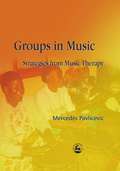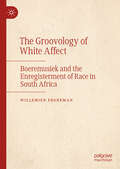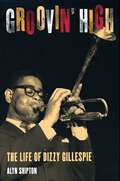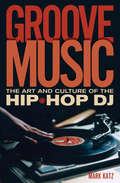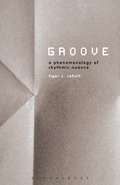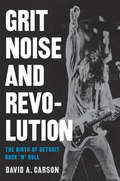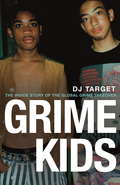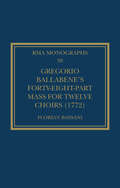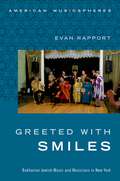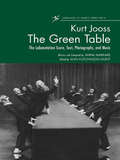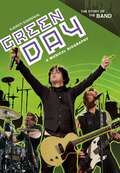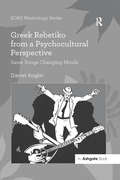- Table View
- List View
Groups in Music: Strategies from Music Therapy (PDF)
by Mercedes PavlicevicMusic in Groups happens all the time: in the street, the classroom, in music colleges, community centres, hospitals, prisons, churches and concert halls; at raves, weddings, music festivals, public ceremonies, music therapy sessions, group music lessons, concerts and rehearsals. Some group musicking seems to 'work' (and play) better than others; some sessions feel exhausting even if things are going well; and at other times, we can't begin to explain the complex musical and relational textures of group music work to funders, employers, friends, colleagues, or line managers. In this book, music therapist Mercédès Pavlicevic develops a broad-based discourse to describe, analyse and guide the practice of group musicking, drawing on her own extensive experience. The text is illustrated with vignettes drawn from a range of formal and informal settings that include spontaneous public occasions, collective rituals, special and mainstream education, music therapy, the concert hall, the music appreciation group and community work. This book makes you think about balancing individual and group needs, the development of group time, dealing with over-enthusiastic performers who 'hog' the group sound, undercurrents in music groups, the complications of dealing with institutions, preparing music listening programmes and buying instruments for group work - if you're involved in any kind of group musicking, this book is for you.
Groundbreaking Guys: 40 Men Who Became Great by Doing Good
by Stephanie True PetersAn illustrated book of biographies highlighting the inspiring and innovative qualities of forty very different men throughout history, for fans of Heroes for My Son and Good Night Stories for Rebel Girls.Our history books are full of great men, from inventors to explorers to presidents. But these great men were not always good men. It's time for our role models to change. This book pays tribute to Mr. Rogers, Barack Obama, Hayao Miyazaki, and more: men whose masculinity is grounded in compassion and care. These men have varying worldviews and are accomplished in a range of fields, but they share important commonalities. They served their communities. They treated people with respect. They lifted others up. And they went on to create change, inspire others, and, indeed, do great things--not in spite of their goodness, but because of it.These men's stories will educate, entertain, and encourage the next generation of writers, activists, entrepreneurs, and other leaders of all genders to do better and be better--to be truly groundbreaking.
The Groovology of White Affect: Boeremusiek And The Enregisterment Of Race In South Africa
by Willemien FronemanGroovin' High: The Life of Dizzy Gillespie
by Alyn ShiptonDizzy Gillespie was one of the most important and best-loved musicians in jazz history. With his horn-rimmed glasses, goatee, jive talk, and upraised trumpet bell, he was the hipster who most personified bebop. The musical heir to Louis Armstrong, he created the modern jazz trumpet-playing style and dazzled aficionados and popular audiences alike for over 50 years. In this first full biography, Alyn Shipton covers all aspects of Dizzy's remarkable life and career, taking us through his days as a flashy trumpet player in the swing bands of the 1930s, his innovative bebop work in the 1940s, the worldwide fame and adoration he earned through his big band tours in the 1950s, and the many recordings and performances which defined a career that extended into the early 1990s. Along the way, Shipton convincingly argues that Gillespie--rather than Charlie Parker as is widely believed--had the greatest role in creating bebop, playing in key jazz groups, teaching the music to others, and helping to develop the first original bebop repertory. Shipton also explores the dark side of Dizzy's mostly sunny personal life, his womanizing, the illegitimate daughter he fathered and supported--now a respected jazz singer in her own right--and his sometimes needless cruelty to others. For anyone interested in jazz and one of its most innovative and appealing figures, Groovin' High is essential reading.
Groove Music: The Art and Culture of the Hip-Hop DJ
by Mark KatzIt's all about the scratch in Groove Music, award-winning music historian Mark Katz's groundbreaking book about the figure that defined hip-hop: the DJ. Today hip-hop is a global phenomenon, and the sight and sound of DJs mixing and scratching is familiar in every corner of the world. But hip-hop was born in the streets of New York in the 1970s when a handful of teenagers started experimenting with spinning vinyl records on turntables in new ways. Although rapping has become the face of hip-hop, for nearly 40 years the DJ has proven the backbone of the culture. In Groove Music, Katz (an amateur DJ himself) delves into the fascinating world of the DJ, tracing the art of the turntable from its humble beginnings in the Bronx in the 1970s to its meteoric rise to global phenomenon today. Based on extensive interviews with practicing DJs, historical research, and his own personal experience, Katz presents a history of hip-hop from the point of view of the people who invented the genre. Here, DJs step up to discuss a wide range of topics, including the transformation of the turntable from a playback device to an instrument in its own right, the highly charged competitive DJ battles, the game-changing introduction of digital technology, and the complex politics of race and gender in the DJ scene. Exhaustively researched and written with all the verve and energy of hip-hop itself, Groove Music will delight experienced and aspiring DJs, hip-hop fans, and all students or scholars of popular music and culture.
Groove Music: The Art and Culture of the Hip-Hop DJ
by Mark KatzIt's all about the scratch in Groove Music, award-winning music historian Mark Katz's groundbreaking book about the figure that defined hip-hop: the DJ. Today hip-hop is a global phenomenon, and the sight and sound of DJs mixing and scratching is familiar in every corner of the world. But hip-hop was born in the streets of New York in the 1970s when a handful of teenagers started experimenting with spinning vinyl records on turntables in new ways. Although rapping has become the face of hip-hop, for nearly 40 years the DJ has proven the backbone of the culture. In Groove Music, Katz (an amateur DJ himself) delves into the fascinating world of the DJ, tracing the art of the turntable from its humble beginnings in the Bronx in the 1970s to its meteoric rise to global phenomenon today. Based on extensive interviews with practicing DJs, historical research, and his own personal experience, Katz presents a history of hip-hop from the point of view of the people who invented the genre. Here, DJs step up to discuss a wide range of topics, including the transformation of the turntable from a playback device to an instrument in its own right, the highly charged competitive DJ battles, the game-changing introduction of digital technology, and the complex politics of race and gender in the DJ scene. Exhaustively researched and written with all the verve and energy of hip-hop itself, Groove Music will delight experienced and aspiring DJs, hip-hop fans, and all students or scholars of popular music and culture.
Groove: A Phenomenology of Rhythmic Nuance
by Tiger C. RoholtWritten by an experienced drummer and philosopher, Groove is a vivid and exciting study of one of music's most central and relatively unexplored aspects. Tiger C. Roholt explains why grooves, which are forged in music's rhythmic nuances, remain hidden to some listeners. He argues that grooves are not graspable through the intellect nor through mere listening; rather, grooves are disclosed through our bodily engagement with music. We grasp a groove bodily by moving with music's pulsations. By invoking the French philosopher Maurice Merleau-Ponty's notion of "motor intentionality," Roholt shows that the "feel" of a groove, and the understanding of it, are two sides of a coin: to "get" a groove just is to comprehend it bodily and to feel that embodied comprehension.
Groove: A Phenomenology of Rhythmic Nuance
by Tiger C. RoholtWritten by an experienced drummer and philosopher, Groove is a vivid and exciting study of one of music's most central and relatively unexplored aspects. Tiger C. Roholt explains why grooves, which are forged in music's rhythmic nuances, remain hidden to some listeners. He argues that grooves are not graspable through the intellect nor through mere listening; rather, grooves are disclosed through our bodily engagement with music. We grasp a groove bodily by moving with music's pulsations. By invoking the French philosopher Maurice Merleau-Ponty's notion of "motor intentionality," Roholt shows that the "feel" of a groove, and the understanding of it, are two sides of a coin: to "get" a groove just is to comprehend it bodily and to feel that embodied comprehension.
Grit, Noise, and Revolution: The Birth of Detroit Rock 'n' Roll
by David A. Carson". . . a great blow-by-blow account of an exciting and still-legendary scene." ---Marshall Crenshaw From the early days of John Lee Hooker to the heyday of Motown and beyond, Detroit has enjoyed a long reputation as one of the crucibles of American pop music. In Grit, Noise, and Revolution, David Carson turns the spotlight on those hard-rocking, long-haired musicians-influenced by Detroit's R&B heritage-who ultimately helped change the face of rock 'n' roll. Carson tells the story of some of the great garage-inspired, blue-collar Motor City rock 'n' roll bands that exemplified the Detroit rock sound: The MC5, Iggy Pop and the Stooges, Mitch Ryder and the Detroit Wheels, SRC, the Bob Seger System, Ted Nugent and the Amboy Dukes, and Grand Funk Railroad. An indispensable guide for rock aficionados, Grit, Noise, and Revolution features stories of these groundbreaking groups and is the first book to survey Detroit music of the 1960s and 70s-a pivotal era in rock music history.
Grime Kids: The Inside Story of the Global Grime Takeover
by DJ TargetAn explosive insider account of grime, from subculture to international phenomenon. *****A group of kids in the 2000s had a dream to make their voice heard - and this book documents their seminal impact on today's pop culture.DJ Target grew up in Bow under the shadow of Canary Wharf, with money looming close on the skyline. The 'Godfather of Grime' Wiley and Dizzee Rascal first met each other in his bedroom. They were all just grime kids on the block back then, and didn't realise they were to become pioneers of an international music revolution. A movement that permeates deep into British culture and beyond. Household names were borne out of those housing estates, and the music industry now jumps to the beat of their gritty reality rather than the tune of glossy aspiration. Grime has shaken the world and Target is revealing its explosive and expansive journey in full, using his own unique insight and drawing on the input of grime's greatest names.
Grétry's Operas and the French Public: From the Old Regime to the Restoration (Ashgate Interdisciplinary Studies in Opera)
by R.J. ArnoldWhy, in the dying days of the Napoleonic Empire, did half of Paris turn out for the funeral of a composer? The death of André Ernest Modeste Grétry in 1813 was one of the sensations of the age, setting off months of tear-stained commemorations, reminiscences and revivals of his work. To understand this singular event, this interdisciplinary study looks back to Grétry’s earliest encounters with the French public during the 1760s and 1770s, seeking the roots of his reputation in the reactions of his listeners. The result is not simply an exploration of the relationship between a musician and his audiences, but of developments in musical thought and discursive culture, and of the formation of public opinion over a period of intense social and political change. The core of Grétry’s appeal was his mastery of song. Distinctive, direct and memorable, his melodies were exported out of the opera house into every corner of French life, serving as folkloristic tokens of celebration and solidarity, longing and regret. Grétry’s attention to the subjectivity of his audiences had a profound effect on operatic culture, forging a new sense of democratic collaboration between composer and listener. This study provides a reassessment of Grétry’s work and musical thought, positioning him as a major figure who linked the culture of feeling and the culture of reason - and who paved the way for Romantic notions of spectatorial absorption and the power of music.
Grétry's Operas and the French Public: From the Old Regime to the Restoration (Ashgate Interdisciplinary Studies in Opera)
by R.J. ArnoldWhy, in the dying days of the Napoleonic Empire, did half of Paris turn out for the funeral of a composer? The death of André Ernest Modeste Grétry in 1813 was one of the sensations of the age, setting off months of tear-stained commemorations, reminiscences and revivals of his work. To understand this singular event, this interdisciplinary study looks back to Grétry’s earliest encounters with the French public during the 1760s and 1770s, seeking the roots of his reputation in the reactions of his listeners. The result is not simply an exploration of the relationship between a musician and his audiences, but of developments in musical thought and discursive culture, and of the formation of public opinion over a period of intense social and political change. The core of Grétry’s appeal was his mastery of song. Distinctive, direct and memorable, his melodies were exported out of the opera house into every corner of French life, serving as folkloristic tokens of celebration and solidarity, longing and regret. Grétry’s attention to the subjectivity of his audiences had a profound effect on operatic culture, forging a new sense of democratic collaboration between composer and listener. This study provides a reassessment of Grétry’s work and musical thought, positioning him as a major figure who linked the culture of feeling and the culture of reason - and who paved the way for Romantic notions of spectatorial absorption and the power of music.
Grenzen des Hörens: Noise und die Akustik des Politischen (Musik und Klangkultur #51)
by David WallrafWas ist der Klang der Macht? Wie verschafft sich Widerstand Gehör? In Grenzen des Hörens widmet sich David Wallraf jenen verdrängten Seiten des Hörbaren, die als Lärm, Rauschen, Geräusche und Störungen vernehmbar werden. Ausgehend von Noise als einem subkulturellen Genre, das die traditionellen Parameter der Musik dekonstruiert, zeichnet er den Begriff bis in Diskurse der Akustik, Thermodynamik und Informationstheorie nach und entwirft dabei eine politisch-ästhetische Theorie des Auditiven. Vor dem Hintergrund seiner Praxis als experimenteller Noise-Künstler legt er mit seiner kenntnisreichen und äußerst lesbaren Abhandlung eine kritische Ergänzung zu den Sound Studies vor.
Gregorio Ballabene’s Forty-eight-part Mass for Twelve Choirs (Royal Musical Association Monographs)
by Florian BassaniNeither Spem in alium, the widely acclaimed ‘songe of fortie partes’ by Thomas Tallis, nor Alessandro Striggio’s forty-part Mass is the largest-scale counterpoint work in Western music. The actual winner is Gregorio Ballabene, a relatively unknown Roman maestro di cappella, a contemporary of Giovanni Paisiello, Joseph Haydn and Luigi Boccherini, who composed in forty-eight parts for twelve choirs. His Mass saw only a public rehearsal and was never performed liturgically despite all of Ballabene’s efforts to promote it. On closer inspection, however, the work deserves special consideration as a piece of outstanding combinatory creativity – the product of a talent able to conceive, structure and realise a project of colossal dimensions. It might even be claimed that if Charles Burney had gained knowledge of it, all derogatory comments by nineteenth-century music historians would not have succeeded in extinguishing the interest of later generations. Ballabene’s Mass has remained completely unstudied until today, even though the score survives in prominent collections. This study offers, for the first time, a historical and analytical perspective on this overlooked manifestation of a very individual musical intelligence.
Gregorio Ballabene’s Forty-eight-part Mass for Twelve Choirs (Royal Musical Association Monographs)
by Florian BassaniNeither Spem in alium, the widely acclaimed ‘songe of fortie partes’ by Thomas Tallis, nor Alessandro Striggio’s forty-part Mass is the largest-scale counterpoint work in Western music. The actual winner is Gregorio Ballabene, a relatively unknown Roman maestro di cappella, a contemporary of Giovanni Paisiello, Joseph Haydn and Luigi Boccherini, who composed in forty-eight parts for twelve choirs. His Mass saw only a public rehearsal and was never performed liturgically despite all of Ballabene’s efforts to promote it. On closer inspection, however, the work deserves special consideration as a piece of outstanding combinatory creativity – the product of a talent able to conceive, structure and realise a project of colossal dimensions. It might even be claimed that if Charles Burney had gained knowledge of it, all derogatory comments by nineteenth-century music historians would not have succeeded in extinguishing the interest of later generations. Ballabene’s Mass has remained completely unstudied until today, even though the score survives in prominent collections. This study offers, for the first time, a historical and analytical perspective on this overlooked manifestation of a very individual musical intelligence.
Gregorian Chant and the Carolingians
by Kenneth LevyA world-renowned scholar of plainchant, Kenneth Levy has spent a portion of his career investigating the nature and ramifications of this repertory's shift from an oral tradition to the written versions dating to the tenth century. In Gregorian Chant and the Carolingians, which represents the culmination of his research, Levy seeks to change long-held perceptions about certain crucial stages of the evolution and dissemination of the old corpus of plainchant--most notably the assumption that such a large and complex repertory could have become and remained fixed for over a century while still an oral tradition. Levy portrays the promulgation of an authoritative body of plainchant during the reign of Charlemagne by clearly differentiating between actual evidence, hypotheses, and received ideas. How many traditions of oral chant existed before the tenth century? Among the variations noted in written chant, can one point to a single version as being older or more authentic than the others? What precursors might there have been to the notational system used in all the surviving manuscripts, where the notational system seems fully formed and mature? In answering questions that have long vexed many scholars of Gregorian chant's early history, Levy offers fresh explanations of such topics as the origin of Latin neumes, the shifting relationships between memory and early notations, and the puzzling differences among the first surviving neume-species from the tenth century, which have until now impeded a critical restoration of the Carolingian musical forms.
Gregorian Chant and the Carolingians
by Kenneth LevyA world-renowned scholar of plainchant, Kenneth Levy has spent a portion of his career investigating the nature and ramifications of this repertory's shift from an oral tradition to the written versions dating to the tenth century. In Gregorian Chant and the Carolingians, which represents the culmination of his research, Levy seeks to change long-held perceptions about certain crucial stages of the evolution and dissemination of the old corpus of plainchant--most notably the assumption that such a large and complex repertory could have become and remained fixed for over a century while still an oral tradition. Levy portrays the promulgation of an authoritative body of plainchant during the reign of Charlemagne by clearly differentiating between actual evidence, hypotheses, and received ideas. How many traditions of oral chant existed before the tenth century? Among the variations noted in written chant, can one point to a single version as being older or more authentic than the others? What precursors might there have been to the notational system used in all the surviving manuscripts, where the notational system seems fully formed and mature? In answering questions that have long vexed many scholars of Gregorian chant's early history, Levy offers fresh explanations of such topics as the origin of Latin neumes, the shifting relationships between memory and early notations, and the puzzling differences among the first surviving neume-species from the tenth century, which have until now impeded a critical restoration of the Carolingian musical forms.
Greeted With Smiles: Bukharian Jewish Music and Musicians in New York (American Musicspheres)
by Evan RapportAs the Soviet Union stood on the brink of collapse, thousands of Bukharian Jews left their homes from across the predominantly Muslim cities of Central Asia, to reestablish their lives in the United States, Israel and Europe. Today, about thirty thousand Bukharian Jews reside in New York City, settled into close-knit communities and existing as a quintessential American immigrant group. For Bukharian immigrants, music is an essential part of their communal self-definition, and musicians frequently act as cultural representatives for the group as a whole. Greeted with Smiles: Bukharian Jewish Music and Musicians in New York explores the circumstances facing new American immigrants, using the music of the Bukharian Jews to gain entrance into their community and their culture. Author Evan Rapport investigates the transformation of Bukharian identity through an examination of corresponding changes in its music, focusing on three of these distinct but overlapping repertoires - maqom (classical or "heavy" music), Jewish religious music and popular party (or "light") music. Drawing upon interviews, participant observation and music lessons, Rapport interprets the personal perspectives of musicians who serve as community leaders and representatives. By adapting strategies acquired as an ethno-religious minority among Central Asian Muslim neighbors, Bukharian musicians have adjusted their musical repertoire in their new American home. The result is the creation of a distinct Bukharian Jewish American identity-their musical activities are changing the city's cultural landscape while at the same time providing for an understanding of the cultural implications of Bukharian diaspora. Greeted with Smiles is sure to be an essential text for ethnomusicologists and scholars of Jewish and Central Asian music and culture, Jewish-Muslim interaction and diasporic communities.
Greeted With Smiles: Bukharian Jewish Music and Musicians in New York (American Musicspheres)
by Evan RapportAs the Soviet Union stood on the brink of collapse, thousands of Bukharian Jews left their homes from across the predominantly Muslim cities of Central Asia, to reestablish their lives in the United States, Israel and Europe. Today, about thirty thousand Bukharian Jews reside in New York City, settled into close-knit communities and existing as a quintessential American immigrant group. For Bukharian immigrants, music is an essential part of their communal self-definition, and musicians frequently act as cultural representatives for the group as a whole. Greeted with Smiles: Bukharian Jewish Music and Musicians in New York explores the circumstances facing new American immigrants, using the music of the Bukharian Jews to gain entrance into their community and their culture. Author Evan Rapport investigates the transformation of Bukharian identity through an examination of corresponding changes in its music, focusing on three of these distinct but overlapping repertoires - maqom (classical or "heavy" music), Jewish religious music and popular party (or "light") music. Drawing upon interviews, participant observation and music lessons, Rapport interprets the personal perspectives of musicians who serve as community leaders and representatives. By adapting strategies acquired as an ethno-religious minority among Central Asian Muslim neighbors, Bukharian musicians have adjusted their musical repertoire in their new American home. The result is the creation of a distinct Bukharian Jewish American identity-their musical activities are changing the city's cultural landscape while at the same time providing for an understanding of the cultural implications of Bukharian diaspora. Greeted with Smiles is sure to be an essential text for ethnomusicologists and scholars of Jewish and Central Asian music and culture, Jewish-Muslim interaction and diasporic communities.
The Green Table: The Labanotation Score, Text, Photographs, and Music
by Ann Hutchinson Guest* Score, photographs, and production details of one of this century's best-loved ballets * Includes rare archival material * Packaged with audio CD This work brings together the complete dance score of The Green Table--one of the most famous ballets of the 20th century--in Labanotation, along with music notation for the piano accompaniment and a complete recording of the accompaniment on CD. It also includes several essays about the work and its genesis, and many historic production photographs. This book is an important item for all colleges with dance programs to own in their libraries and for scholars interested in the study of contemporary dance.
The Green Table: The Labanotation Score, Text, Photographs, and Music
by Ann Hutchinson Guest* Score, photographs, and production details of one of this century's best-loved ballets * Includes rare archival material * Packaged with audio CD This work brings together the complete dance score of The Green Table--one of the most famous ballets of the 20th century--in Labanotation, along with music notation for the piano accompaniment and a complete recording of the accompaniment on CD. It also includes several essays about the work and its genesis, and many historic production photographs. This book is an important item for all colleges with dance programs to own in their libraries and for scholars interested in the study of contemporary dance.
Green Day: A Musical Biography (The Story of the Band)
by Kjersti EgerdahlHere is an up-to-date, thoroughly researched biography of the world's most popular pop-punk band.Green Day is almost certainly the world's most popular pop-punk band. How they got there is the subject of Green Day: A Musical Biography, the first book to follow the band from their beginnings through the spring 2009 release of 21st Century Breakdown. Tracing the band's evolution from fiercely independent punks to a global powerhouse, Green Day starts with the members' earliest musical influences and upbringing and the founding of the punk club 924 Gilman Street that shaped their sense of community. Discussion of their conflicted feelings about signing to a major label explores the classic rock 'n' roll conundrum of "selling out," while details of their decline and 2004 rebirth offer an inspirational story of artistic rejuvenation. Interviews with the band members and key figures in their lives, excerpted from punk 'zines and other publications, offer a perspective on their methods of self-promotion and the image they have chosen to project over time.
Green Day: A Musical Biography (The Story of the Band)
by Kjersti EgerdahlHere is an up-to-date, thoroughly researched biography of the world's most popular pop-punk band.Green Day is almost certainly the world's most popular pop-punk band. How they got there is the subject of Green Day: A Musical Biography, the first book to follow the band from their beginnings through the spring 2009 release of 21st Century Breakdown. Tracing the band's evolution from fiercely independent punks to a global powerhouse, Green Day starts with the members' earliest musical influences and upbringing and the founding of the punk club 924 Gilman Street that shaped their sense of community. Discussion of their conflicted feelings about signing to a major label explores the classic rock 'n' roll conundrum of "selling out," while details of their decline and 2004 rebirth offer an inspirational story of artistic rejuvenation. Interviews with the band members and key figures in their lives, excerpted from punk 'zines and other publications, offer a perspective on their methods of self-promotion and the image they have chosen to project over time.
Greek Rebetiko from a Psychocultural Perspective: Same Songs Changing Minds (SOAS Studies in Music Series)
by Daniel KoglinGreek Rebetiko from a Psychocultural Perspective: Same Songs Changing Minds examines the ways in which audiences in present-day Greece and Turkey perceive and use the Greek popular song genre rebetiko to cultivate specific cultural habits and identities. In the past, rebetiko has been associated chiefly with the lower strata of Greek society. But Daniel Koglin approaches the subject from a different perspective, exploring the mythological and ritual aspects of rebetiko, which intellectual elites on both sides of the Aegean Sea have adapted to their own world views in our age of globalized consumption. Combining qualitative and quantitative methods from ethnomusicology, ritual studies, conceptual history and music psychology, Koglin casts light on the role played by national perceptions in the processes of music production and consumption. His analysis reveals that rebetiko persistently oscillates between conceptual categories: it is a music both ours and theirs, marginal and mainstream, joyful and grievous, sacred and profane. The study culminates in the thesis that this semantic multistability is not only a key concept to understanding the ongoing popularity of rebetiko in Greece, and its recent renaissance in Turkey, but also a fundamental aspect of the human experience on the south-eastern borders of Europe.
